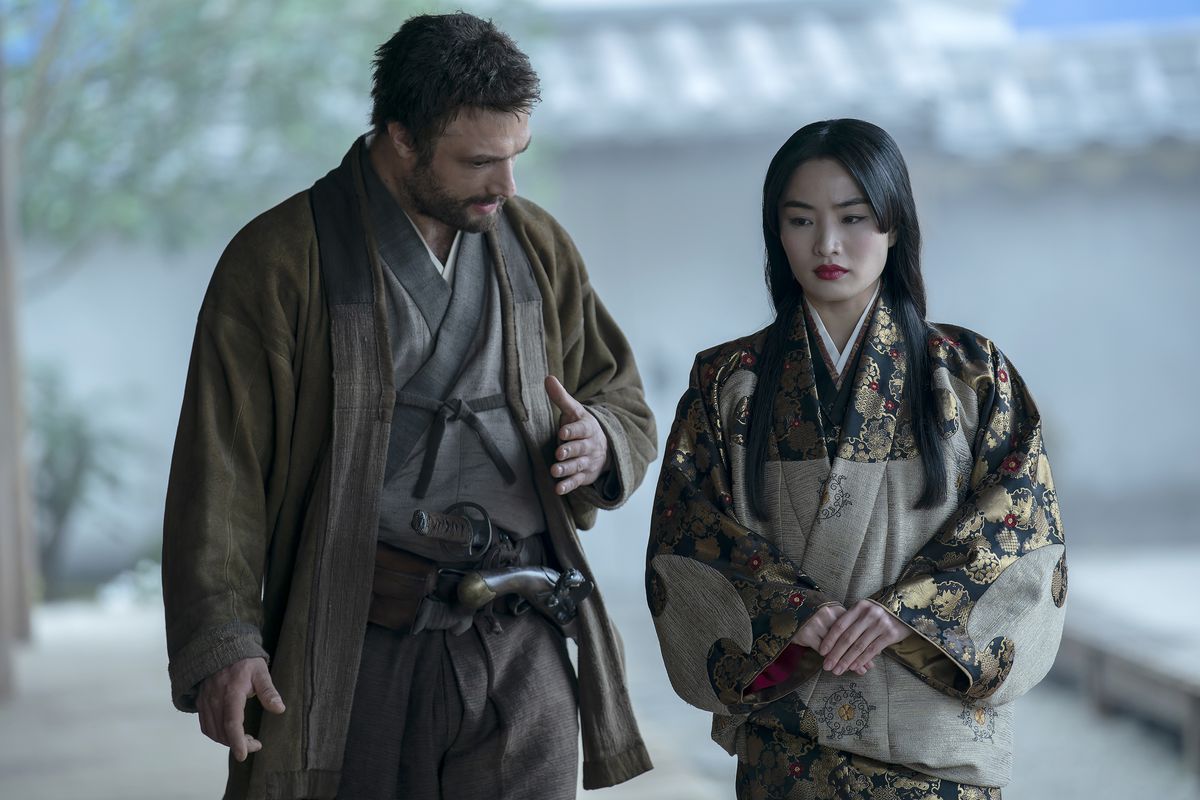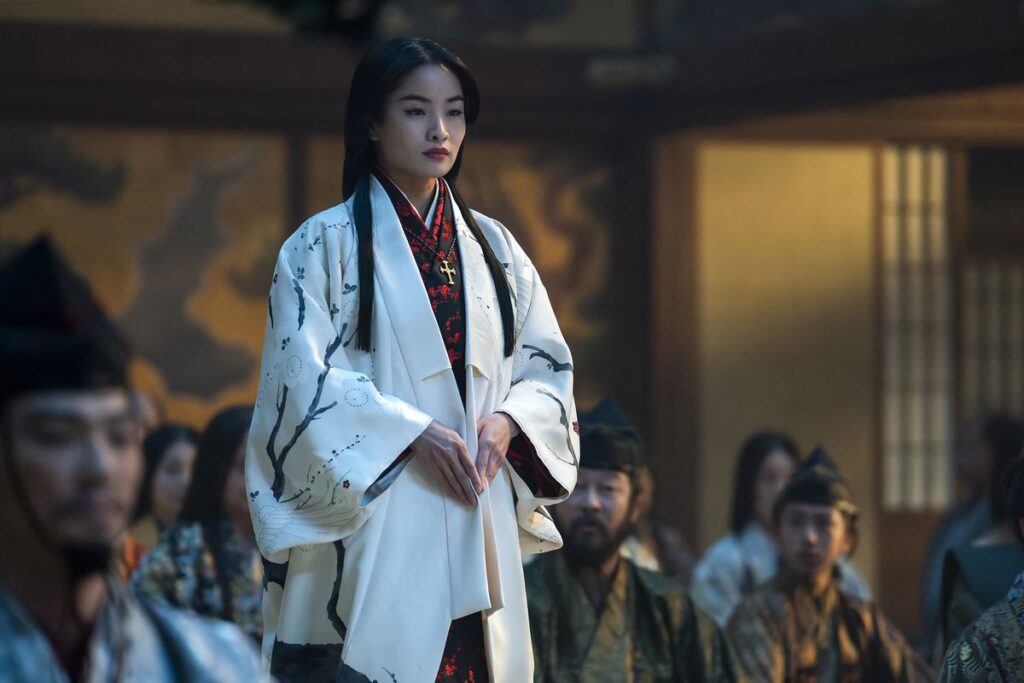The penultimate episode of Shōgun is a big one, in the way only great TV can build to. It binds together everything the past eight hours of the show has built, then punctures the plotlines like daisy chains. And the result is explosive, even before the final moments blow up everything we understand about where this story might be headed. Episode 9, “Crimson Sky,” brings the whole conflict to a fiery head — so it’s no wonder it prominently features the plotline the show’s creators, by their own admission, struggled with the most.
[Ed. note: This post will now get into explicit spoiler territory for “Crimson Sky.”]
Photo: Katie Yu/FX
When trying to nail down all the details of Shōgun’s period world, showrunners Rachel Kondo and Justin Marks brought in producer Mako Kamitsuna as a cultural consultant. When seeking notes, they — like anyone undergoing an edit — were hopeful they had shot the moon.
“We thought, OK, she’s gonna be like, How did you guys do this? You captured the Japanese essence,” Kondo told Polygon. “And she very politely said, ‘I’m sorry, I’m not able to give you notes about this, because a Japanese person wouldn’t even have this thought.’”
As Marks and Kondo saw it, it was a classic case of not knowing what they didn’t know. “[It] really challenged us to break it down from the beginning and start over. At first you’re shocked, and then you’re challenged, and then you’re inspired — and I think that’s what happened at almost every level,” Kondo says.
One particular note stood out to them: “The meaning of seppuku and a true understanding of why it was used,” Marks says. “Even after the writers room with our Japanese producers and actors, there were a lot of conversations about us trying to reach for: What does seppuku mean?”
The answer to that question is weighed across “Crimson Sky,” particularly as various people try to talk or maneuver Mariko (Anna Sawai) out of her resolve to commit seppuku. Though, as we saw in last week’s episode, it is some sort of ploy on behalf of her lord, Toranaga (Hiroyuki Sanada), no one is exactly sure what or why.
Perhaps nowhere is this clearer than in her conflict with Blackthorne. Part of their connection has been based in his similar thoughts on death; while her husband (Shinnosuke Abe) is left stiff and distant as he struggles to understand Mariko’s desire to commit seppuku, Blackthorne relates to the idea that death is a part of everyday life. And that ease of understanding has underpinned much of their feelings toward each other as the season progressed. But Shōgun is a smart show, and knows their understanding is founded off totally different circumstances, cultural contexts, and conceptions of death. It’s something Marks and Kondo say they can relate to.

Photo: Katie Yu/FX
“We, I think, as Westerners, for a long time were interpreting [seppuku] almost as a pathos, as like a fixation on death,” Marks says. “[But] seppuku, as an act — I believe as it was put to us by Mako Kamitsuna — is more an expression of life. And that was a really potent conversation that opened our eyes to our misunderstanding as we engaged it through the text originally. To exert this act on a chaotic situation is a chance to exert control over chaos; to take one’s life into their own hands and say that I can have some agency over it.”
It’s just as we saw last week, with Toranaga’s friend and ally Toda Hiromatsu (Tokuma Nishioka) also committing seppuku. That scene is similarly charged, with the layers of understanding — between Toranaga and Hiromatsu, first and foremost, but also for the crowd around them to interpret their performance of ritual — and the weight of the act comes through completely. Though Mariko’s seppuku doesn’t happen exactly (more on that later), both she and Hiromatsu demonstrate their willingness to commit to Toranaga’s cause, to register their very real purpose with an act. And Shōgun treats both of these moments as sacrifices that are respected but mourned: Nishioka and Sanada both look on the verge of tears throughout their scene, both desperate to aid the other, yet unable to do more than they can muster here. Even Mariko’s declaration is met with a bowed head from Toranaga’s wife and the other ladies at court.
Through that lens, Kondo and Marks came along a similar journey to Blackthorne’s: He originally sees Mariko’s choices purely as Toranaga’s manipulation, having observed her somewhat performative attempt at an exit and generally fearing for her life. He even seeks to exploit his connection with her, begging, “Would you consider living for me?” She takes his hand and looks at him with pity and sadness, breaking him when she walks away. Ultimately he listens to her, and accepts that he may not understand her choices, but he can support her in the only ways he knows how: following her lead (and seconding her, so as to save her mortal soul from Christian hell). Without knowing, he has done the thing her husband never could: giving her the freedom of a life beyond anyone else’s understanding, logic, or control.
In an episode all about pawns and the people that move them, Mariko’s steadfastness is remarkable, and even those who can’t understand have no choice but to stare. It’s her journey that defines “Crimson Sky,” even just in the way the camera meets her gaze. After declaring directly to the camera that she was “ready” for her part in Toranaga’s plan, “Crimson Sky” holds Mariko in the center of the frame and the story, ferociously asserting herself as she stares right back into it. Even when she glides past it after failing to battle through Ishido’s men, there’s a sense that she’s seeing further down the line than we are. With her final sacrifice, she is, in her own way, exerting her control over history as best she can. It may be Toranaga’s master plan, and Ishido’s kidnapping attempt, but it’s Mariko who sends the final blow.
Shōgun’s series finale drops next Tuesday.

